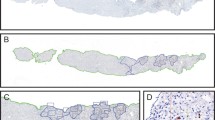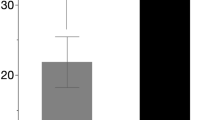Abstract
The liver tissue of 26 chidren with biliary atresia was compared to that of 20 adults with autoimmune chronic active hepatitis, 20 adults with chronic hepatitis due to hepatitis B infection, and 5 children with α1-antitrypsin deficiency in terms of the number and type of mononuclear cells in portal and lobular areas of each using a panel of specific monoclonal antibodies that recognize different cell surface epitopes. All of the tissues studied were obtained at time of liver transplantation. In addition the livers of 5 adults biopsied for hepatomegaly but found to have no histologic liver disease were used as normal controls for this study. The results demonstrate that liver tissue obtained from children with end-stage biliary atresia is more like normal liver in terms of the number and type of mononuclear cells present than in either of the two types of adult liver diseases. Moreover although the liver of children with end-stage α1-antitrypsin deficiency is more like that of normal liver than either of the two adult liver diseases studied in terms of the number and type of mononuclear cells within the liver, it is less similar to that of normal adult liver than is liver tissue obtained from children with biliary atresia. These findings suggest that as a morphologic basis biliary atresia is unlikely to be due to either a viral or an autoimmune attack upon the liver.
Similar content being viewed by others
References
Landing BH: Considerations of the pathogenesis of neonatal hepatitis, biliary atresia and choledochal cyst—the concept of infantile obstructive cholangiopathy. Prog Pediatr Surg 6:113–137, 1974
Glaser JH, Morecki R: Reovirus type 3 and neonatal cholestasis. Semin Liver Dis 7:100–107, 1987
Bandaru B, Morecki R, Glaser JH, Gartner LM, Horwitz MD: Comparative studies of biliary atresia in the human newborn and reovirus-induced cholangitis in weanling mice. Lab Invest 43:456–462, 1980
Morecki R, Glaser J, Cho S, Balistreri W, Horwitz M: Serologic evidence of reovirus type III infection biliary atresia. N Engl J Med 307:481–484, 1982
Morecki R, Glaser JH, Johnson AB, Kress Y: Detection of reovirus type 3 in porta hepatis of an infant with extrahepatic biliary atresia: Ultrastructural and immunocytochemical study. Hepatology 4:1137–1142, 1984
Dussaix E, Hadchovel M, Tardieu M, Allagille D: Biliary atresia and reovirus type 3 infection. N Engl J Med 310:658, 1984 (letter)
Rosenburg DR, Morecki R, Lollini LO, Glaser J, Cornelius CE: Extrahepatic biliary atresia in a rhesus monkey (Macaca mulatta). Hepatology 3:577–580, 1983
Glasser JH, Balistreri WF, Morecki R: Role of reovirus type 3 in persistent infantile cholestasis. J Pediatr 105:912–915, 1984
Cornelius CE, Rosenburg DP: Neonatal biliary atresia. Am J Pathol 118:168–171, 1985
Balistreri WF, Tabor E, Gerety RJ: Negative serology for hepatitis A and B viruses in 18 cases of neonatal cholestasis. Pediatrics 66:269–271, 1980
Stanley NF, Dorman DC, Pinsford J: Studies on the pathogenesis of a hitherto undescribed virus (hepatoencephalomyelitis) producing unusual symptoms in suckling mice. Aust J Exp Biol Med Sci 31:147–159, 1953
Phillips PA, Keast D, Papadimitriou JM, Walters MNI, Stanley NF: Chronic obstructive jaundice induced by reovirus type 3 in weanling mice. Pathology 1:193–203, 1969
Papadimitriou JM: The biliary tract in acute murine reovirus type 3 infection. Am J Pathol 52:595–611, 1968
Glaser JH, Balistreri WF, Morecki R: Role of reovirus type 3 in persistent infantile cholestasis. J Pediatr 105:912–915, 1984
Desmet VJ: Cholangiopathies: Past, present, and future. Semin Liver Dis 7:67–76, 1987
Ludwig J, Czaja AJ, Dickson R: Manifestations of nonsuppurative cholangitis in chronic hepatobiliary diseases: Morphologic spectrum, clinical correlations and terminology. Liver 4:105–116, 1984
Kangnian C, Demetris AJ, Van Thiel DH, Whiteside T: A double immunoenzyme staining method for analysis of tissue and blood lymphocyte subsets with monoclonal antibodies. Lab Invest 56:114–119, 1987
Si L, Whiteside TL, Schade RR, Starzl TE, Van Thiel DH: Studies of T lymphocyte subsets in liver tissues of patients with primary biliary cirrhosis, primary sclerosing cholangitis and normal controls. J Clin Immunol 4:262–272, 1984
Si L, Whiteside TL, Schade RR, Van Thiel DH: Studies of lymphocyte subpopulations in the liver tissue and blood of patients with chronic active hepatitis. J Clin Immunol 3:408–419, 1983
Picket HC: Biliary obstruction secondary to hepatic vascular ligation in fetal sheep. J Pediatr Surg 4:95–101, 1976
Author information
Authors and Affiliations
Additional information
This work was supported in part by grants AA04425-07 and NIDDK DK32556-05.
Rights and permissions
About this article
Cite this article
Chen, K., Gavaler, J.S., Van Thiel, D.H. et al. Phenotypic characterization of mononuclear infiltrate present in liver of biliary atresia. Digest Dis Sci 34, 1564–1570 (1989). https://doi.org/10.1007/BF01537111
Received:
Accepted:
Issue Date:
DOI: https://doi.org/10.1007/BF01537111




